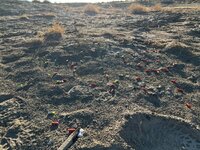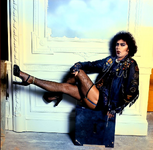RockAndSage
WKR
So, there's some clarification points that should be made here...the biggest is that there are many reasons lighter-recoiling helps produce better shooters in field realities:
This is part of the equation, but a secondary one - the bigger part resides in making the absolute best first shot possible, no matter the situation at hand.
This psychological reaction has got to be hardwired into the Y-chromosome. Bigger weapon = bigger man. Smaller weapon = p*ssy who can't handle manhood. Along with, "I am man, I am tool master."
The absence of this is also why women learn to shoot better, faster, all else being equal.
Have you tried this basic measurement of field-shooting competence with the .338 yet?
This is actually a pretty big miss, my friend. There's also some commonly held Fudd-lore in this take on things. The reality is that any accuracy difference between large vs small cartridges from "muzzle wiggle" as the bullet leaves would be so tiny that it would be hard to measure from a fixed bench-mounted shooting fixture. It has zero bearing on human capabilities with that gun.
The reality is that the far larger part of "lighter recoiling = better shooting" is that it's psychological.
The easiest way to test this, is to fire 10 rounds out of your .338 from any position not prone, at a target 100yds out. Even better if you do it within that test I linked above.
Then do it again, but mix in a couple of snap-caps/dummy rounds, in a way where you have zero idea where they are.
Your flinch will be revealed on the snap-cap shot, and will be utterly embarrassing.
That flinch isn't coming from anticipated pain - most of it is coming from a combination of overall anticipated sensory load and mindshare of operations. It's the combo of performance-demand in the mental-physical mechanics of executing the fundamentals of a shot, anticipating the moment of trigger-press, recovering from the shot, getting back on target, assessing the shot, tension about what that shot means, and taking next steps. Every bit of this sensory and mental loading is magnified as recoil goes up, along with varying microseconds of mental-load shock with a violent strike to your body.
The more sensory load you can remove, the less mindshare will be occupied on it, and the more you can focus on excellence in your fundamentals and cycling through it.
All shooting is 95% mental. The more sensory-mental load you can remove, the better.
EDIT: I personally have a round-count of somewhere around low/mid 6-figures of pistol ammo I've fired over the last 40 years. This is a photo of part of my normal routine - IIRC, on this day it was about 50 snap caps randomly mixed in over the course of about 300rds of fire. To this day, I can count on 1 hand the number of times I've made it through 50 snap-caps without flinching at least once. This is just 9mm. Flinching's not about pain, it's what happens with an imbalance between sensory load and mental focus.
The small caliber evangelists are advocating for minimizing recoil to aid in spotting shots not because of physical discomfort.
This is part of the equation, but a secondary one - the bigger part resides in making the absolute best first shot possible, no matter the situation at hand.
man what a bunch of pussies
This psychological reaction has got to be hardwired into the Y-chromosome. Bigger weapon = bigger man. Smaller weapon = p*ssy who can't handle manhood. Along with, "I am man, I am tool master."
The absence of this is also why women learn to shoot better, faster, all else being equal.
I don't miss with this thing and it's basically a giant death ray
Have you tried this basic measurement of field-shooting competence with the .338 yet?
The thought process is that the physics involved dictate that all other things equal, the lighter recoiling rifle will be more consistent. Nothing to do with pain tolerance or anything like that, it's just physics. The muzzle is going to wiggle around less before the bullet leaves
This is actually a pretty big miss, my friend. There's also some commonly held Fudd-lore in this take on things. The reality is that any accuracy difference between large vs small cartridges from "muzzle wiggle" as the bullet leaves would be so tiny that it would be hard to measure from a fixed bench-mounted shooting fixture. It has zero bearing on human capabilities with that gun.
The reality is that the far larger part of "lighter recoiling = better shooting" is that it's psychological.
The easiest way to test this, is to fire 10 rounds out of your .338 from any position not prone, at a target 100yds out. Even better if you do it within that test I linked above.
Then do it again, but mix in a couple of snap-caps/dummy rounds, in a way where you have zero idea where they are.
Your flinch will be revealed on the snap-cap shot, and will be utterly embarrassing.
That flinch isn't coming from anticipated pain - most of it is coming from a combination of overall anticipated sensory load and mindshare of operations. It's the combo of performance-demand in the mental-physical mechanics of executing the fundamentals of a shot, anticipating the moment of trigger-press, recovering from the shot, getting back on target, assessing the shot, tension about what that shot means, and taking next steps. Every bit of this sensory and mental loading is magnified as recoil goes up, along with varying microseconds of mental-load shock with a violent strike to your body.
The more sensory load you can remove, the less mindshare will be occupied on it, and the more you can focus on excellence in your fundamentals and cycling through it.
All shooting is 95% mental. The more sensory-mental load you can remove, the better.
EDIT: I personally have a round-count of somewhere around low/mid 6-figures of pistol ammo I've fired over the last 40 years. This is a photo of part of my normal routine - IIRC, on this day it was about 50 snap caps randomly mixed in over the course of about 300rds of fire. To this day, I can count on 1 hand the number of times I've made it through 50 snap-caps without flinching at least once. This is just 9mm. Flinching's not about pain, it's what happens with an imbalance between sensory load and mental focus.



